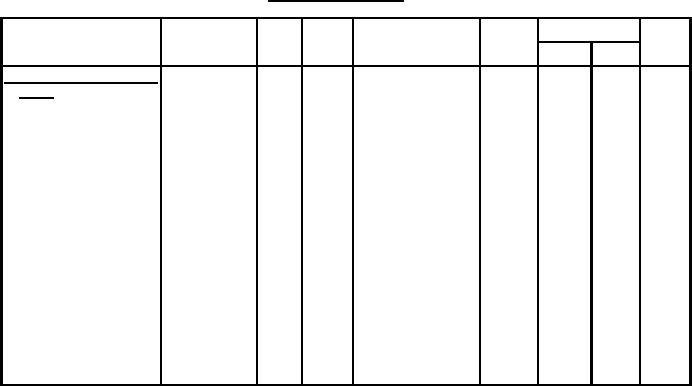
MIL-PRF-1/272F
TABLE I. Testing and inspection - Continued.
Limits
Method
Inspection
Types Notes
Conditions
Symbol
Unit
MIL-STD-1311
Min
Max
Conformance inspection,
part 3
Life test
---
P1
---
Group C;
---
---
---
---
t = 500 hours (min);
light = 4.0 ftL;
Eb2 = 2,750 V dc
P11
---
Group C;
---
---
---
---
t = 500 hours (min);
light = 2.25 ftL;
Eb2 = 2,750 V dc
Life-test end points:
Line width "A"
5226
P1
---
Light = 3.4 ftL
Width
---
0.45
mm
Line width "B"
5226
P1
---
Light = 3.4 ftL
Width
---
0.45
mm
Modulation
ĆEc
5223
P1
---
Light = 3.4 ftL
---
48
V dc
Life-test end points:
Line width "A"
5226
P11
---
Light = 2.25 ftL
Width
---
0.45
mm
Line width "B"
5226
P11
---
Light = 2.25 ftL
Width
---
0.45
mm
Modulation
ĆEc
5223
P11
---
Light = 2.25 ftL
---
48
V dc
1. The construction of this gun shall be of the zero Ib1 type. The following information and material are to be
forwarded with the four regular samples when application for qualification approval is made:
1 each gun drawings with significant dimensions.
1 each sample of gun to be used in manufacture of tubes.
2. This value is recommended only for low-velocity deflecting and low-ambient light levels.
3. The deflecting plates shall be returned to anode No. 2 through a minimum of 2.5 mΩ resistors. Ib3, the beam
current, shall be set at 50 µA dc. The high-frequency scanning shall be applied to the deflecting plates nearest
the screen and the amplitude shall be adjusted to give a line length of approximately 90 percent of the maximum
tube diameter. The low-frequency scanning amplitude shall be expanded to approximately 90 percent of the
maximum tube diameter in the direction perpendicular to the direction of high-frequency scanning. Readjustment
may be made for best overall focus. The tube shall be observed for deflection defocusing, astigmatism, or spot
ellipticity observable to the eye as evidenced by fuzziness due to lack of sharpness of trace (usually around
edges), bow-tying (irregular widths of any single line when observed at different points), bowing of trace other than
that normally caused by curvature of bulb. This test for focus is to be made in addition to the line width
measurements.
4. The same conditions shall be set up as described in note 3 except that the connection of deflecting elements to
the low- and high-frequency scanning supplies shall be interchanged and the amplitudes adjusted to 90 percent of
the maximum tube diameter in both directions without any adjustment of focus from conditions in note 3. An
examination for defocusing, astigmatism, or spot ellipticity shall be made as in note 3.
5. As measured by a 2 x 2-inch (50.8 x 50.8 mm) raster using a type 3 photronic cell without eye correction,
calibrated in footcandles of illumination from a light source having color temperature of 2,700°K.
6. The test is made with maximum voltage (Egl maximum negative voltage) applied to the base pins, and deflection
electrodes if applicable, only; and pressure of 30,000 feet (225 mmHg). Connections should be made in a
manner that does not degrade the tube's electrical voltage breakdown characteristics. Satisfactory operation is
the absence of arc-over and corona.
7. This test to be performed at the conclusion of the holding period.
4
For Parts Inquires call Parts Hangar, Inc (727) 493-0744
© Copyright 2015 Integrated Publishing, Inc.
A Service Disabled Veteran Owned Small Business